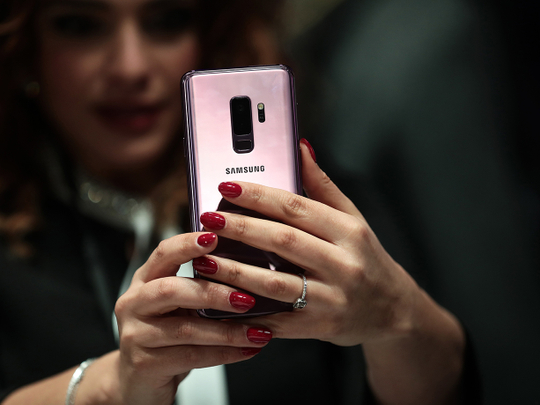
Barcelona: Samsung has stuck to the same design of last year’s S8 model for its new Galaxy flagships S9 and S9+, albeit with improvements in hardware such as enhanced camera capabilities to differentiate itself from competition and to keep pace with Apple’s camera advancements.
Face-off: Samsung S9 vs iPhone X
Samsung has launched the devices earlier than it did the S8 launch in March last year to steal more market share from other vendors.
S9 devices will be the first smartphones of the year to hit the shelves on March 16, including in the UAE. Prices were not disclosed.
The S9 has a 5.8-inch Quad HD OLED ‘Infinity Display’ with 4GB of RAM and 64/128/256GB (depending on the region) of storage capacity. The fingerprint sensor is moved from the side to below the single lens camera. The battery capacity is 3,000mAh.
The 12MP rear camera will have a variable aperture (f/1.5-f/2.4) with optical image stabilisation. The front camera is 8MP with f/1.6 aperture and supports super slow motion.
The 6.22-inch S9+ has a 6GB of RAM and 64/128/256GB of ROM (depending on the region). It will have a new 12MPdual-lens camera setup (wide and telephoto) on the back and 8MP on the front. Battery capacity is 3,500mAh. The chipset is the same as S9.
The Galaxy S9 series has also added adjustable aperture in the camera, which allows for automatic switching from f/2.4 to f/1.5 for better low-light performance.
The phones can pass 28 per cent more light to the sensor than S8 and 30 per cent more noise reduction than S8.
The dual speakers are powered by AKG with 360-degree surround sound.
The voice assistant Bixby gets an update (translation, places and food calorie).
The secondary telephoto lens features a Live Focus mode for creating portrait mode or bokeh effect.
The major changes in terms of the camera include slow-motion video recording at 960 frames per second, similar to what Sony did with Xperia Premium , improved low-light photography and an iPhone X-like emoji feature.
It uses augmented reality facility and creates a 3D image of the person and turns it into a customised emoji; it can create 18 different emojis of the person.
In slow motion, the camera records 0.2 seconds of the clip and plays back in 0.6 seconds. It automatically detects the object in the frame of the camera and starts recording.
A new version of the DeX docking station was also unveiled, to connect it to a monitor to have a PC-like experience.












